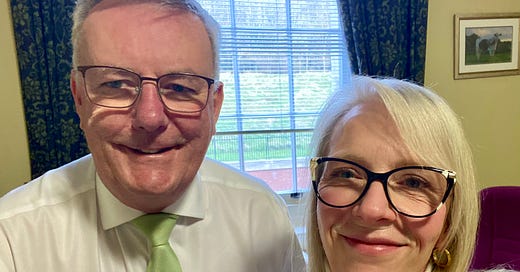You know your policy issue inside and out. You’ve got the stats, the research, and the moral argument to back it up. So why aren’t policymakers listening?
The truth is, a great policy idea isn’t enough—how you communicate it matters just as much as the substance itself. If your message isn’t clear, compelling, and strategically framed, it won’t get the attention (or action) it deserves.
Here are the most common messaging mistakes that turn policymakers off—and how to fix them so your advocacy gets results.
🚫 Mistake #1: Too Much Jargon, Not Enough Clarity
💬 What policymakers hear: "Blah blah blah… strategic policy framework… multi-sectoral approach… systems-based thinking…"
Policymakers don’t have time to decode technical language—if your message isn’t clear in seconds, it gets ignored.
✅ Fix it:
Use plain language—if a 12-year-old wouldn’t understand it, simplify it.
Lead with the core issue and impact, not the policy mechanics.
Example: Instead of “This initiative will create cross-sectoral collaboration for improved service integration,” say:
👉 “This policy will make it easier for families to access mental health support without jumping through hoops.”
🚫 Mistake #2: No Clear Ask
💬 What policymakers hear: "Okay… but what do you want me to do about it?"
If your message only explains the problem without a specific action policymakers can take, you’re leaving them guessing. And guess what? They won’t guess.
✅ Fix it:
Be specific—instead of saying, “We need better mental health services,” say:
👉 “We need an additional £10M allocated to community mental health hubs in the next budget.”Make it actionable—what is the one thing they can say yes to today?
Give them options—if they can’t commit to your main ask, suggest smaller steps they can take now.
🚫 Mistake #3: Focusing on the Problem, Not the Solution
💬 What policymakers hear: "Another complaint with no real fix."
It’s easy to get stuck in highlighting what’s wrong—but policymakers are looking for practical, politically feasible solutions.
✅ Fix it:
Spend less time on the problem and more time on how to fix it.
Show how your solution aligns with their priorities.
Example: Instead of just saying “Suicide rates are rising,” say:
👉 “A simple change—mandatory suicide prevention training for all frontline health workers—could save lives.”
🚫 Mistake #4: Not Making It Politically Relevant
💬 What policymakers hear: "This is interesting… but not my priority."
Even if your issue is important, it won’t get traction unless it’s politically relevant to them.
✅ Fix it:
Tie your issue to their priorities—what do they care about? Jobs? Public spending? Public safety?
Use local data—policymakers care most about their constituents, not abstract stats.
Example: Instead of saying “Climate action is urgent,” say:
👉 “Renewable energy investment could create 2,500 jobs in your constituency.”
🚫 Mistake #5: Talking at Policymakers Instead of Engaging Them
💬 What policymakers hear: "Another lecture… yawn."
Advocacy isn’t just about presenting your case—it’s about starting a conversation. If your messaging is one-way, it won’t get traction.
✅ Fix it:
Ask questions that make them think—e.g., “How does this fit into your government’s priorities?”
Invite collaboration—e.g., “What would make this a workable policy for your party?”
Frame your message as an opportunity, not a demand.
🔑 Final Takeaway: Advocacy is About Framing
Even the best policy ideas won’t gain traction if they aren’t communicated well. The key is to:
✔ Keep it clear, simple, and relevant.
✔ Focus on solutions, not just problems.
✔ Make the ask specific and politically realistic.
✔ Engage in dialogue, not just demands.
🎯 Want help crafting a winning advocacy strategy that actually gets results? Let’s chat. Drop me a message, and let’s make your message one that policymakers can’t ignore.
Struggling to Get Policymakers to Listen? Here’s Why (and How to Fix It).
You’ve done the research.
You’ve written the policy brief.
You’ve sent the email… And then? Silence.
📌 No reply.
📌 No action.
📌 No change.
It’s not that policymakers don’t care—it’s that they don’t have time for unclear, unfocused, or overly long messages.
If your policy message isn’t clear, concise, and aligned with their priorities, it will get ignored.
That’s why I’ve created this practical, no-fluff course to show you:
✅ The 3-step formula for a message that gets read—and acted on
✅ How to structure the perfect one-page policy brief
✅ How to frame your ask so it aligns with what policymakers care about
Policymakers will listen—when you know how to make them.
💡 Want a bargain? Get 20% OFF (Use code 20OFF)
🔗 Sign up here
Earn CPD Points With My Podcast
Did you know you can earn Continuing Professional Development (CPD) points by listening to my podcast, Policy360: Unplugged?
🎧 Listen here: https://www.buzzsprout.com/2254501/episodes
Support My Work: Buy Me a Coffee
If you’ve found value in this newsletter, my podcasts, or my training resources, consider supporting my work. Whether it’s signing up for a paid subscription or buying me a coffee, your support helps me continue to create practical, actionable content to help you succeed in advocacy.
☕ Support me here: https://buymeacoffee.com/policy360
Thank you so much.
Until next time,
Ellen





